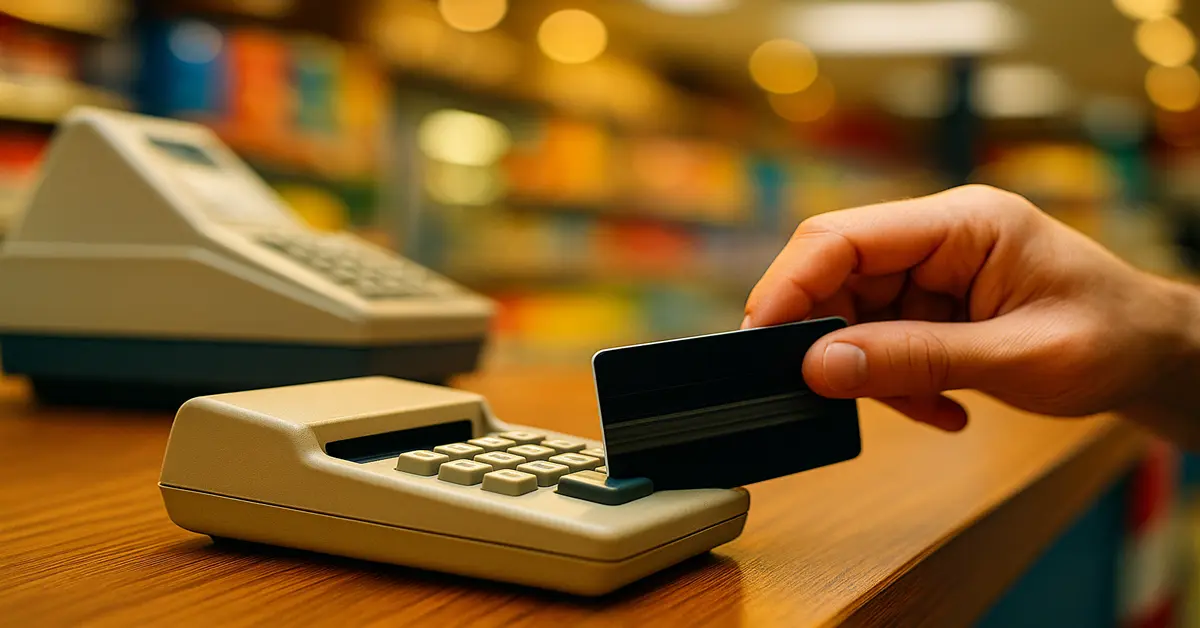Magnetic Stripe Credit Card History USA — The Swipe Revolution of the 1970s
Magnetic stripe credit card history in the USA began in the 1970s, when swipe terminals replaced manual imprinters across American stores. The stripe lets cashiers read card data instantly, speed authorizations, and cut paperwork—turning card payments into an everyday habit. This article explains where the stripe started, how swiping worked, the early security upgrades, and how the swipe era paved the way for EMV chips and today’s contactless wallets.
For the full timeline, see our History of Credit Cards in America.
Estimated reading time: 5 min read
Published: Sep 23, 2025

Visa History USA 1958 — BankAmericard Origins & Amex First Charge Card
The Backstory Before 1958
Before Visa’s history in the USA 1958 began, America’s payment world was already shifting from cash to cards. In the early 1950s, Diners Club launched a charge card, giving USA consumers their first chance to pay without paper money. Soon after, Bank of America prepared its own program, while American Express entered the race with its early card product. These experiments shaped consumer habits, introduced new ways to pay, and fueled industry competition. This wave of change laid the foundation for Visa’s future growth—turning small pilots into one of the world’s most trusted networks.
Introduction
The Visa history USA 1958 milestone was more than a card launch—it marked the birth of modern American credit. That year, Bank of America introduced the BankAmericard pilot program in California, letting families shop now and pay later with ease. At the same time, Amex first charge card 1958 entered the market, aimed at premium users and changing spending culture. Together these breakthroughs built the foundation of a shared credit network—what would eventually evolve into Visa, a global brand trusted by millions worldwide.
🌱 Origins and First Launch (1958)
Visa history USA 1958 truly began when Bank of America introduced BankAmericard at scale in California, giving everyday shoppers a simple way to buy now and pay later with a bank-backed card. For the first time, stores could process standardized slips and route approvals through clear procedures, speeding checkout and record-keeping. In the same year, American Express entered with a pay-in-full charge card aimed at business and travel spend. Two distinct models—revolving credit vs. charge—sparked rapid merchant onboarding, fresh consumer habits, and the competitive momentum that would later shape the modern Visa network.
Surprise: Ready-to-use cards and quick merchant sign-ups made plastic payments feel mainstream.
Challenge: Early fraud, late payments, and staff training gaps slowed adoption.
Achievement: By the early 1960s, performance stabilized and card usage expanded beyond big cities.
Positioning: Amex leaned into prestige and travel; BankAmericard targeted broad, mass-market households.
Milestone: 1958 set the foundation for the open-loop network that evolved into Visa.
🚀 Business Model and Early Growth
The Visa history USA 1958 playbook mixed direct issuance, clear merchant rules, and visible branding—driving trust on both sides of the counter.
Pilot Launch Model: Local seeding (e.g., California) created dense acceptance, monthly billing, and repeat use.
Merchant Acceptance: Faster lanes and higher ticket sizes encouraged retailers to join and display acceptance marks.
Risk Management: Hot-card lists, verification calls, and tighter underwriting reduced losses over time.
Consumer Trust: Itemized statements, dispute paths, and transparent fees turned first-time users into loyal cardholders.
Social Impact: Carrying a card became a sign of financial progress—expanding access to travel, dining, and everyday essentials.
🌎 National Expansion and Competition
The BankAmericard origins seeded a playbook that soon stretched coast-to-coast, putting card payments into everyday U.S. life and forcing rivals to move faster.
Rapid expansion: In just a few years, BankAmericard spread nationwide, giving millions a new way to shop and pay.
Amex charge card (1958): A premium, pay-in-full option that raised consumer awareness and pushed Visa’s future upgrades.
Licensing model: Banks across the country issued their own BankAmericard-branded cards, accelerating acceptance.
Visa rebrand (1976): BankAmericard unified under the Visa name, signaling global reach and standards.
Competitive impact: Visa vs Amex rivalry drove faster innovation, clearer rules, and better service for cardholders and merchants.
💻 Technological Innovations
The Visa history USA 1958 story is also a tech timeline—each step making payments faster, safer, and easier to scale.
1958: Large-scale bank card pilot proved multi-bank credit could beat cash and checks for everyday use.
1960: Amex’s early electronic authorizations improved security for higher-value transactions.
1970: Network upgrades cut fraud and made revolving credit more reliable for U.S. shoppers.
2000: Rollout of contactless and tap-to-pay boosted speed and convenience at the checkout.
Today: From digital wallets to mobile pay, Visa leads secure payments across the USA and worldwide.
👥 Impact on American Consumers
Magnetic stripe credit card history USA made card payments an everyday habit—lines moved faster, receipts were cleaner, and acceptance spread from gas pumps to grocery checkouts.
Speed & convenience: swipe-and-go checkout cut waiting time at thousands of U.S. merchants.
Wider access: middle-income households could plan bigger purchases with revolving credit.
Everyday categories: fuel, food, pharmacies, and travel counters normalized card use.
Record keeping: printed slips simplified returns, warranties, and monthly budgeting.
Small-business lift: quicker lanes and higher ticket sizes helped local stores grow.
Trust & habits: regular swiping built confidence and paved the path to chip and contactless.
Consumer education: statements and clear totals taught millions how to manage card spend.
⚠️ Criticism and Challenges
The swipe era also had pain points—useful lessons that later pushed the industry toward chips and tap-to-pay.
Late payments & interest: carrying balances created debt stress for many new users.
Fraud & skimming risk: exposed magnetic data invited misuse until controls improved.
Training gaps: clerks learned ID checks, voids, and slip storage the hard way.
Chargebacks & disputes: handwritten totals and manual batches sometimes caused errors.
Card wear & demagnetization: damaged stripes led to declined transactions at checkout.
Fees & pushback: some merchants resisted card costs before volume benefits showed up.
Accessibility issues: not all communities got terminals at once, slowing nationwide parity.
Lesson learned: fixing these issues accelerated the move to EMV chips and contactless.
🏆 Legacy
Magnetic stripe credit card history USA turned swiping into America’s everyday habit and set the rails for modern electronic payments—clearer authorizations, cleaner records, and a blueprint that later powered chips, tap-to-pay, and mobile wallets.
From corner stores to airports, swipe became the default at checkout.
Standard rules for receipts, settlements, and disputes built merchant trust.
Consumer confidence grew as statements and protections matured.
Networks scaled nationwide, then exported the playbook globally.
The swipe era laid the path for today’s contactless and digital wallets.
👉 From a simple stripe in the 1970s to today’s digital-first world, the journey shaped how America pays—and how the world followed.
Lessons for U.S. Consumers (1970s Swipe Era)
The magnetic-stripe “swipe” age changed how Americans paid—faster checkouts, standardized rails, and early e-authentication paved the way for today’s EMV and tap-to-pay. Here are practical takeaways readers can use now.
Pay on time, every time: automate payments and keep utilization under ~30% to protect your score.
Treat credit as a tool, not cash: aim to pay statement balances in full to avoid interest.
Prefer chip or tap over swipe: EMV/contactless adds security; only swipe when no other option exists.
Turn on security alerts: enable transaction notifications, use 2FA, and lock your card in the app if lost.
Know your dispute rights: keep receipts; chargeback rules exist to fight fraud and billing errors.
Choose the right card, not the shiniest perk: weigh rewards vs. annual fees and acceptance where you shop.
Build long-term history: keep your oldest good account open; avoid unnecessary closures.
Travel & online safety: notify issuers for trips, use virtual card numbers where offered, and avoid public Wi-Fi at checkout.
Conclusion
Magnetic stripe credit card history USA shows how the 1970s swipe era sped up checkout, standardized data across banks, and enabled early electronic authorizations. That same foundation made the jump to EMV chips, contactless tap-to-pay, and today’s digital wallets possible.
For consumers, the lesson is simple: use modern protections (chip/tap, alerts, strong passwords), pay on time, and pick cards that match how you spend—so speed and security work in your favor.
👉 Ready to pick a card that fits your wallet? Compare today’s best credit cards in USA.
👉 Want the full timeline? Read our complete history hub on U.S. credit cards.
💡 Top Credit Quote Code

Top Credit Quote — Your Trusted Guide to USA Credit Cards & Smart Finance
🏆 About the Top Credit Quote Editorial Team
Top Credit Quote is an independent U.S.–focused credit card and finance review platform. We go beyond surface-level details—digging into issuer disclosures, comparing card perks, and analyzing real-life spending impact. Our goal: help you choose the best credit cards in the USA with 100% clarity and trust.
✨ What sets us apart:
✅ Evidence-based reviews — every benefit, fee, and fine print explained in plain English.
✅ Real value checks — first-year perks vs. ongoing rewards vs. annual fees.
✅ Weekly updates — fresh offers, interest rate changes, and fast editorial edits.
✅ Clear guidance — who should apply for a card and who should skip it.
✅ Independent rankings — affiliate links never decide our ratings.
✅ Corrections policy — if we miss something, we fix it quickly and transparently.
👉 Top Credit Quote — Your trusted USA guide for credit cards, rewards, and smarter finance.
